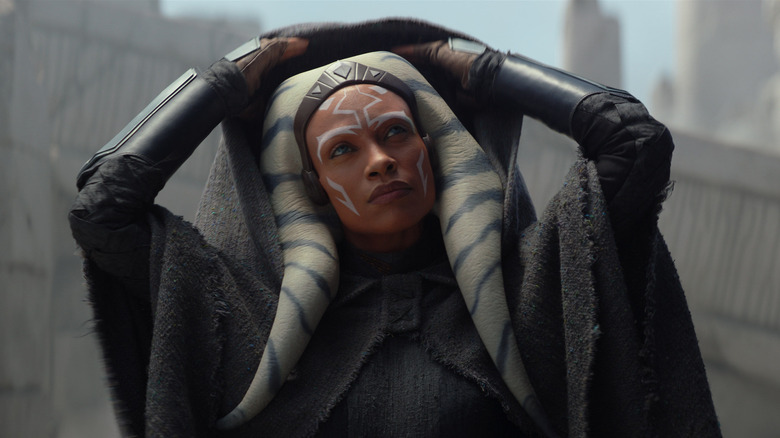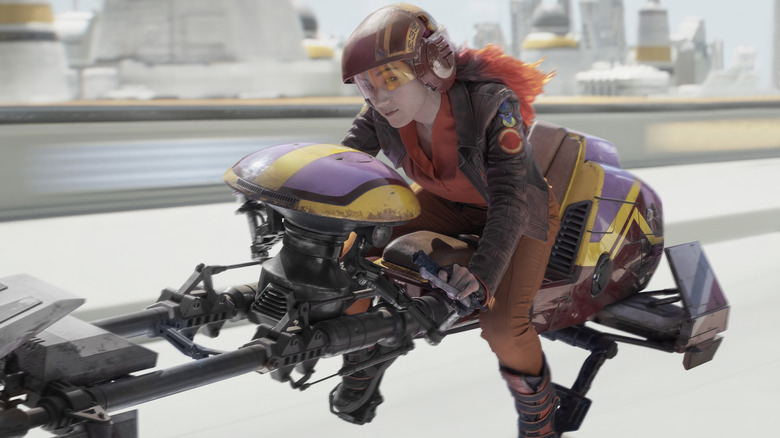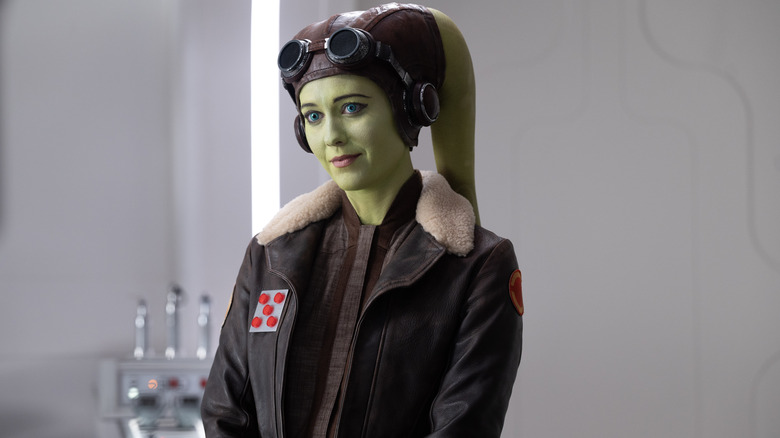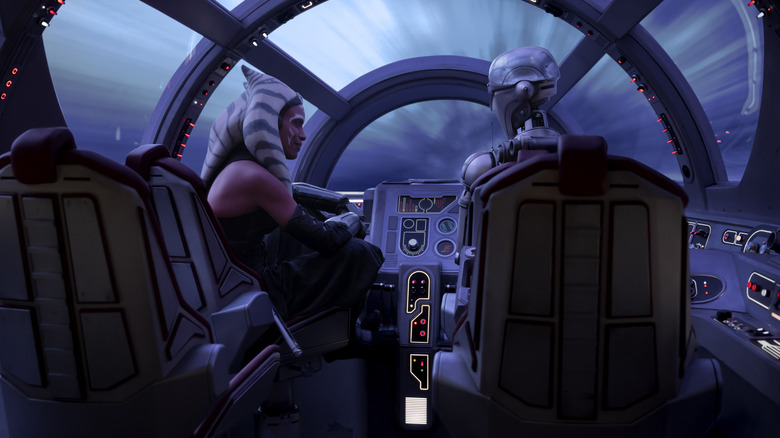Ahsoka Review: The Force Is With This Star Wars Show, But It's No Jedi (Yet)
Watching the first episode of "Ahsoka," I kept wishing George Lucas had been around during filming to provide the same direction he, as "Star Wars" legend has it, gave the cast of "A New Hope": "Faster, more intense." It's advice that Lucas's real-life Padawan, Lucasfilm Animation head honcho and "Ahsoka" showrunner Dave Filoni, could stand to take to heart.
Filoni comes from the world of animation, having gotten his start as a storyboard artist on "King of the Hill" prior to working with Lucas on the animated series "Star Wars: The Clone Wars." Animation, by its very nature, necessitates economic storytelling. It's much more expensive than live-action, so every shot has to maximize its ability to advance the narrative. You can tell Filoni enjoyed the extra leeway afforded by his initial excursion into live-action as a writer, director, and executive producer on "The Mandalorian" and "The Book of Boba Fett." But in the "Ahsoka" premiere, which Filoni helmed in addition to writing, he's far too unhurried, to the detriment of the episode. "Star Wars" can be many things, but it should never be stagnant.
It feels like Filoni is trying to impersonate Akira Kurosawa here, combining slower and more introspective moments with bursts of vibrant, dynamic action. It's something he excels at in his animated "Star Wars" shows, which often include scenes of characters in quiet reflection or silently performing mundane tasks in-between exhilarating space battles, lightsaber duels, or chases. The problem is, he slows the talkier scenes and contemplative beats down way too much in the "Ahsoka" premiere, and even some of the action could stand to be punchier — the non-lightsaber fights, that is. Thankfully, "Ahsoka" kicks things up a notch once the laser swords start flying, largely thanks to stunt coordinator Ming Qiu's grounded yet vigorous choreography.
The Rebels strike back
"Ahsoka" picks up where "The Mandalorian" and "The Book of Boba Fett" left off, following its namesake (Rosario Dawson, who's got the older, more haunted, and stoic Ahsoka down pat) as the former Jedi attempts to recover a star map linked to the long-missing "Star Wars Rebels" villain Grand Admiral Thrawn (Lars Mikkelsen, who doesn't appear in the first two episodes made available to critics). Helpfully, the premiere begins with an opening crawl — one that bucks "Star Wars" tradition with its red letting and the absence of John Williams' iconic score — explaining how Thrawn's return would galvanize the Imperial remnants already in the midst of undermining the New Republic in the wake of the Galactic Empire's defeat. It's a quick-and-dirty yet overall effective way of getting everybody on the same page.
This might be a good time to address the bantha in the room: Is "Ahsoka" really just a sequel to "Rebels" (which Filoni co-created and oversaw) disguised as a "Mandalorian" spinoff? The answer is yes ... and no. The premiere episode really wants to bridge the gap between that animated series and the Mando-verse without leaving anyone behind, beginning with the re-introduction of several key players from "Rebels." While it remains to be seen how Eman Esfandi fares as the live-action Ezra Bridger (he only appears as a recorded hologram in the first two episodes), Mary Elizabeth Winstead unsurprisingly has little trouble finding her groove as the battled-hardened yet maternal Twi'lek New Republic general and ace pilot Hera Syndulla. However, it's Natasha Liu Bordizzo who makes the strongest impression right out the gate, nicely playing up the Mandalorian warrior/street artist Sabine Wren's stubborn streak and rebellious attitude (even if she does start off the series pulling a dick move that, frankly, feels excessive).
The world between worlds
Some of the exposition here works better than others, particularly when it concerns Ahsoka taking on Sabine as her Padawan prior to their falling out (which occurred offscreen at some point after "Rebels" ended). Other times, you get clumsy moments like Ahsoka reminding Hera who Thrawn is, as though the latter could somehow forget the individual who, among other things, was complicit in the death of the man she loved, Kanan Jarrus. Speaking of which, "Ahsoka" has yet to mention Ezra's Jedi mentor by name. In fact, every time the show cuts to a shot of Sabine's mural of her and the other "Rebels" leads, it feels like the camera is awkwardly trying to keep Kanan out of the frame. One only hopes the series finds a way to at least nod to such a pivotal "Rebels" character, lest it do to him what "The Mandalorian" did to Satine Kryze.
Kanan's "erasure" thus far speaks to the tricky position "Ahsoka" occupies as a bridge between the live-action and animated worlds of "Star Wars" ... a world between worlds, if you will. Fortunately, as the series' sole writer, Filoni steadily improves at balancing the expectations of longtime "Rebels" fans with making "Ahsoka" function as a standalone chapter within the larger "Mandalorian" saga over the first two episodes. Episode 2 even picks up the pacing a bit, with Steph Green ("Watchmen," "The Book of Boba Fett") taking over as director and infusing some welcome (and needed) momentum into the proceedings. This is also where we get the best re-introduction of a "Rebels" character yet thanks to a scene involving the droid Chopper, whose short-tempered nature and chaotic lawful tendencies are — I'm pleased to report — present and accounted for here.
A Padawan with potential
As with most of the other live-action "Star Wars" series, "Ahsoka" was filmed on a StageCraft soundstage (commonly referred to as The Volume), and the virtual production technology continues to yield mixed returns. The series' premiere benefits from utilizing the same pleasing, earthy color palette as "Rebels," which serves to better distinguish the show visually from those that came before it. Filoni's animation background also makes itself apparent in the striking compositions that fill out the series premiere, particularly during the sequences set on Lothal (Ezra's home planet and the primary setting for "Rebels," for those who're not familiar). Like "The Mandalorian" and "The Book of Boba Fett," though, the limitations of StageCaft once again rear their head here. There's nothing to rival the world's slowest speeder chase from "Boba Fett," thank goodness, but there are multiple scenes during episode 2 especially where it's painfully obvious the show's actors are merely performing in front of a digital backdrop.
Is "Ahsoka" worth watching? I think so. As uneven as the first two episodes are, there's plenty to admire (I'm only now mentioning longtime "Star Wars" animation composer Kevin Kiner's enthralling score) and even greater potential for the series as a whole. I realize that might sound like damning with faint praise, but I can honestly say that's not the case. There's a compelling story being woven here — one as spiritually rich and politically-charged as the best "Star Wars" narratives before it — and as things progress, it may yet prove just as rewarding for "Star Wars" animation enthusiasts as it is for more casual viewers. To paraphrase an exchange between two key characters in episode 2 on the subject of inherent promise, "Ahsoka" itself is the only thing standing in the show's way right now.



